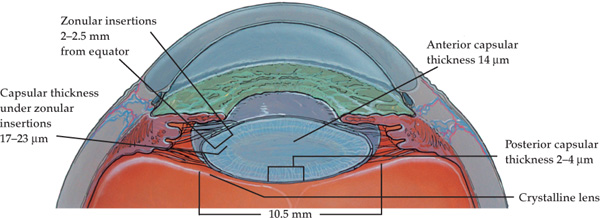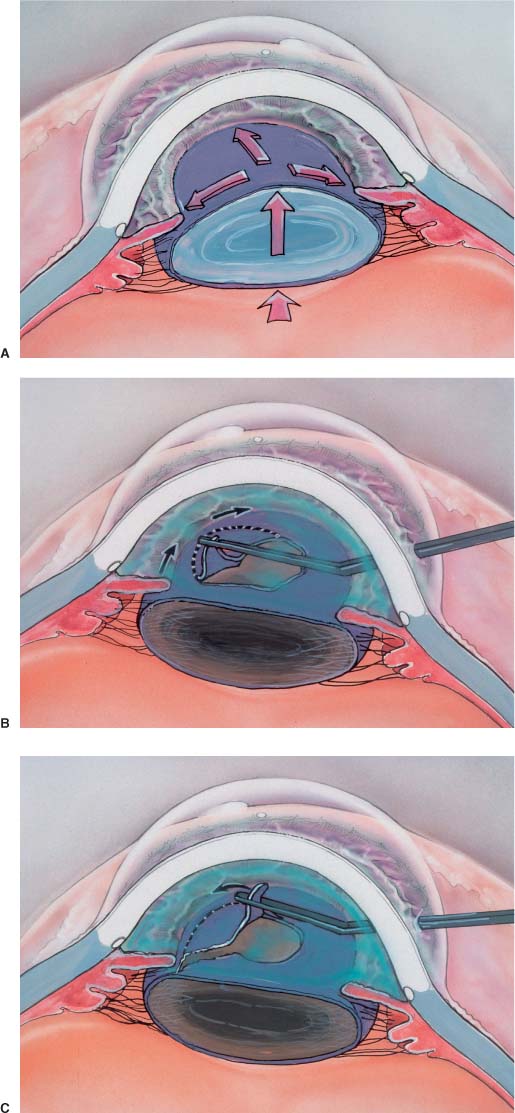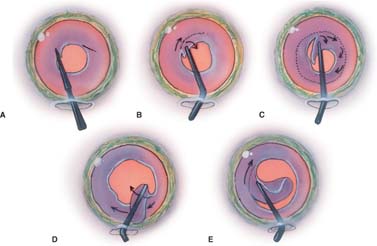Chapter 5 The development of continuous-tear curvilinear capsulorrhexis (CCC) by Gimbel and Neuhann in the 1990s was essential for the development of modern phacoemulsification techniques. This technique has virtually replaced the can-opener capsulotomy as a safer, more tear-resistant method for opening the anterior capsule, even for planned extracapsular cataract extraction.1–5 Creating a tear-resistant CCC provides the basis for complication-free phacoemulsification. An intact capsular bag is critical for complete removal of the native lens and cortex and important for implant centration and stability. Even in cases with zonular dehiscence, an intact capsular bag may allow placement of a capsular tension ring and an in-the-bag posterior lens implant. Although intra- and postoperative complications of CCC are not common, there is the potential for vision loss as a direct result of mismanagement of potential complications. Thus, should a problem occur during the creation of the CCC, the surgeon should immediately attempt to rectify the problem so as to prevent further compromise to the surgery and minimize the risk of postoperative problems. In our experience, properly performed CCC with in-the-bag intraocular lens (IOL) placement has reduced the incidence of intraoperative and postoperative complications.6–22 It is helpful to consider the key anatomic features of the lens capsule and to keep these in mind while performing both CCC and phacoemulsification. The capsule is an elastic basement membrane made up of type IV collagen (Fig. 5–1). This basement membrane is laid down by the lens epithelial cells, which reside just inside the capsule; residual lens epithelial cells are responsible for the postoperative capsular opacification and capsular contraction. This may result in the need for neodymium:yttrium-aluminum-garnet (Nd:YAG) laser treatment following cataract extraction.23–26 The zonules insert on the anterior capsule over an area 2 to 2.5 mm in breadth. Therefore, if the crystalline lens is on average 10.5 mm, and the anterior zonules insert 2.5 mm from the equator, a capsulorrhexis greater than 5.25 mm will tear some of the more anterior zonules. Occasionally, a zonule may insert more anteriorally than usual. This can redirect the tearing capsule toward the equator. The capsule may be as thin as 2 to 4 μm at the posterior pole. It is thickest (17 to 23 μm) near the anterior and posterior equator where the zonular fibers attach.27 The anterior capsule can be as thick as 14 μm in adults and continues to increase in thickness with age. The posterior capsule may be particularly fragile in cases with congenital posterior lenticonus and posterior polar cataract; age-related or corticosteroid-related posterior subcapsular (PSC) cataracts involve migration and enlargement of the lens epithelial cells posteriorly where the capsule is thinnest.28 The surgeon must also be aware of factors such as age, disease (such as pseudoexfoliation or Marfan’s syndrome), or a history of ocular trauma, which may predispose to zonular weakness or dehiscence. Zonular dehiscence will also be discussed in Chapter 9. FIGURE 5–1 The lens capsule is made up of type IV collagen. It is a basement membrane laid down by the lens epithelial cells residing just inside the capsule. There are a variety of methods described for performing CCC.1,29–32 One technique is to puncture the anterior capsule with a sharp needle. This is then exchanged for a capsulorrhexis forceps and the CCC is completed as described below. Gimbel and Kaye1 described their currently preferred method of forceps-puncture CCC in 1997. This technique has the advantage of using only a single instrument but does require the use of viscoelastic. This technique begins with viscoelastic injection into the anterior chamber following the creation of a scleral tunnel or clear corneal incision, and paracentesis. Viscoelastic is important as it flattens the anterior capsule and provides both protection to the corneal endothelium and resistance to forward pressure of the vitreous against the lens. This forward pressure creates a vector force, which will drive the tear peripherally. Viscoelastic minimizes the anteriorly directed force of the lens against the tearing anterior capsule. Thus, the tendency for the capsular tear to extend toward the equator is neutralized. To create the initial central anterior capsular puncture, the forceps should be held with the tips together in a tilted fashion pointing toward the center of the lens. Assuming a superior incision, the capsulotomy is started just proximal to the center by applying downward and forward pressure to puncture the capsule (Fig. 5–2A). After the initial puncture is made, the tip of the forceps is lifted and extended forward a bit to create either a triangular or linear tear toward 6 o’clock. The initial tear is then gently guided to the 3 o’clock position by pulling slightly and moving the tip of the forceps toward the left (Fig. 5–2B). Without releasing the forceps the tear is continued around to approximately the 12 o’clock position, where it can be easily regrasped closer to the point of tearing for better control. The continuous tear can then proceed counterclockwise to complete the CCC using a shearing technique. Upon reaching the outer edge of the 9 o’clock tear the CCC is finished by drawing the tear inward (Fig. 5–2C). To avoid the tendency for the tear to proceed peripherally, the tip of the forceps should always be just behind the advancing tear. The tip of the forceps should then be directed such that the force of the movement is in anticipation of the intended direction of the tear. Often, the vector force of the tear is such that the force tends to be directed somewhat centrally as the circular tear is created. If a tear begins to extend peripherally, the surgeon should stop immediately. The possibility of positive posterior pressure should be entertained (Fig. 5–3A). This pressure will cause the lens to move anteriorally and create a vector force toward the periphery. This force will drive the tear relentlessly into the equator. Causes of increased posterior pressure should be minimized. The speculum should be loosened, the drapes relaxed, and if topical anesthesia is being utilized and the patient is squeezing the eyelids, additional sedation may be necessary. Once these problems are remedied, additional viscoelastic, preferably dispersive (i.e., Viscoat) should be added to further deepen the anterior chamber and flatten the anterior capsule/lens surface (Fig. 5–3B). This will alleviate the tendency for the capsular tear to extend peripherally. Then the capsular edge should be gently grasped immediately adjacent to the tear, and guided back with a careful movement directed centrally. If an anterior tear cannot be turned back toward the center using the forceps, a small area of the can opener technique can be utilized to remove this section of the capsule. Then a small strip of capsule encompassing a short tear can be created to avoid radial extension of the tear.2,23,32 If the tear cannot be turned back, and it extends well into the equator, the capsulorrhexis can be completed from the opposite direction (Fig. 5–3C). This type of rhexis is obviously not continuous. Therefore, in this situation, or anytime a capsule tear disappears under the iris such that its peripheral extent cannot be visualized, the surgeon must expend due care to prevent the extension of the tear around the equator and into the posterior capsule. In this circumstance, excess pressure during hydrodissection, phacoemulsification, and cortex removal, all of which may cause the tear extension, must be avoided. Additional principles of management in these cases are discussed below. FIGURE 5–2 The Gimbel-modified Kraff-Utrata forceps is used to create the initial anterior capsular tear (A) as well as to perform the continuous-tear capsulorrhexis (B,C). The edge of the capsule is regrasped (B) and guided in a controlled fashion to complete the capsulorrhexis at the 3 o’clock position by drawing the tear inward (C). In small-pupil cases the use of a centrally directed tearing motion may move the side of the lens into view and enhance the visibility of a capsulorrhexis edge that is larger than the pupil opening. In this setting extreme care must be taken to ensure that, at the completion of the rhexis the ends of the tear overlap, that is, the tear is completed from the outside toward the inside of the capsule edge. This will ensure that there are no nicks, or triangular edges, in the capsule. During later steps in the procedure the angled edge has the potential to extend peripherally. It may be helpful, in addition, to use a second instrument through the paracentesis to gently push the iris aside for better visibility. The use of additional viscoelastic between the iris and anterior capsule is another method to lift and help enlarge the pupillary aperature.33,34 Although, some surgeons may be able to accurately assess the location of the tear by noting the location of the folding of the anterior capsule as the CCC proceeds, even if it is hidden by the iris, direct visualization of the CCC as it is being performed is recommended. If the pupil is too small for these measures it should be enlarged with one of the methods described in Chapter 6. If the resulting CCC is too small, it can be enlarged by using Gills-Walsh Vannas scissors directed in a tangential counterclockwise direction to begin a slightly more peripheral tear (Fig. 5–4A). Care should be taken not to close the scissors completely as the tips closing will create a jagged end to the snip. The new flap edge created in this way can then be directed using a forceps (Figs. 5–4B–E). There is debate regarding the optimum size for the capsulorrhexis. Three significant factors that determine CCC size are (1) the relationship of the capsular opening to the size and maturity of the cataract, and the expected phaco procedure to be performed; (2) the size of the optic of the anticipated IOL; (3) anatomic abnormalities of the zonules. The rhexis opening must allow adequate access to the cataract. In cases of nuclear mature, hard brown cataracts, too small a rhexis predisposes to rupture of the posterior capsule during the hydrosteps (see Chapter 7). Nuclear manipulation is facilitated by the creation of a larger rhexis. The likelihood of creating a tear in the anterior capsule during phaco is minimized with additional size for maneuvering. Should a tear occur, however, the risk of more significant complications exists. The tear does not have to extend very far to progress to or through the equator and destabilize the remaining anterior capsular support for a sulcus-placed IOL. FIGURE 5–3 (A) Positive pressure from behind the lens will create a vector force that will direct the tear to extend toward the equator. (B) Deepening the anterior chamber with dispursive viscoelastic will flatten the anterior lens surface and counteract these vector forces. The tear can then be redirected toward the center of the nucleus. (C) The tear cannot be redirected. It is therefore completed from the opposite direction. FIGURE 5–4 A small continuous-tear curvilinear capsulorrhexis (CCC) can be enlarged using Gills-Walsh Vannas scissors to begin a slightly more peripheral tear (A). A forceps can then be used with the same technique as described for the primary CCC to gently guide the direction of the tear to create a larger CCC (B,C). The new CCC is then carefully finished in an inward direction (D,E). This method may be used intentionally in a two-staged capsulorrhexis technique in cases of mature cataract or in cases with a small traumatic opening in the anterior capsule. In the case of white, cortically mature cataracts, a smaller CCC may be acceptable. This is discussed in greater detail below. In relation to IOL optic size, some surgeons feel that the capsulorrhexis should be larger than the optic and advocate the use of a large (5.5 to 6 mm) capsulorrhexis. The anterior and posterior capsules are then polished. A modified chalazion curette is utilized to clean lens epithelial cells.23 Postoperatively this will permit the edge of the anterior capsule to adhere to the posterior capsule, and produce a Soemmering’s ring. The theory is that the resultant effect will be the creation of a seal with subsequent isolation and inability of the lens epithelial cells to migrate across the posterior capsule.23 Others, including the authors, recommend that the CCC should be slightly smaller and concentric with the IOL, so that no portion of the anterior capsule CCC edge can fuse to the posterior capsule. The IOL edge therefore creates a mechanical barrier to lens epithelial cell migration behind the IOL. This theory is confirmed by the decreased incidence of YAG capsulotomy seen in association with the thick angular edge of the Alcon Acrylic MA 30 or 60 IOL. In addition, concentric placement balances the forces of the contracting capsular bag, hence minimizing the tendency for postoperative IOL movement. Asymmetrical CCC will result in part of the CCC being over the IOL and part being larger than the IOL and therefore over the posterior capsule. This often may lead to subsequent asymmetrical fibrosis, which often will nudge the lens to an eccentric position. In addition, where the anterior and posterior capsule are in contact there will be fusion of the capsule. This is often the initial site where lens epithelial cells can migrate across the posterior capsule, resulting in folds or a fibrous thickening and opacification of the posterior capsule. A second reason that we favor a CCC smaller than, and concentric with, the optic is to maintain the compartmentalization of the eye even after Nd:YAG laser posterior capsulotomy. In a study that we performed, we found that the initial pressure spike after Nd:YAG laser capsulotomy did not occur when the lens was completely sequestered in the capsular bag.6 There was a significant pressure spike when the lens was in the sulcus or when the IOL optic was partly in the bag and partly out of the bag. We postulate that the sequestering of the anterior chamber by the seal created when the optic of the IOL is completely covered by the capsulorrhexis becomes a barrier against liquefied vitreous coming into the anterior chamber. This may also reduce the possibility of pseudophakic glaucoma.
CAPSULORRHEXIS COMPLICATIONS
CAPSULAR ANATOMY
SURGICAL TECHNIQUE OF CONTINUOUS TEAR CURVILINEAR CAPSULORRHEXIS
AVOIDANCE OF PERIPHERAL EXTENSION OF THE TEAR
CAPSULORRHEXIS TECHNIQUE FOR SMALL-PUPIL CASES
CAPSULORRHEXIS SIZE
CATARACT SIZE AND TYPE
IOL OPTIC SIZE
Stay updated, free articles. Join our Telegram channel

Full access? Get Clinical Tree






